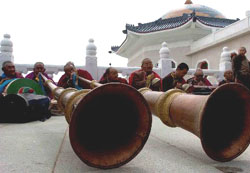
More than 10,000 people attended a grand ceremony on Tuesday at
Genghis Khan's mausoleum, located in Ejin Horo Banner on the Ordos
Highlands in north China's Inner Mongolia Autonomous Region.
Braving blustery winds, people from across China flocked to the
mausoleum to make an offering to Khan, a 13th-century Mongolian
warrior who unified Mongol tribes and became the Great Khan of the
Mongol Empire.
People chanted sutras, prayed for good fortune and a grand rite
was performed by the Dalhut people, who for generations have
defended Khan's mausoleum. Dressed in colorful traditional
costumes, the troupe of Dalhut offered tea, mutton and a pungent
butter at an alter to Khan.
Tuesday's ceremony was the most solemn and the largest of the 60
special offerings held at the mausoleum through out the year, said
Wangchuge, a scholar at Genghis Khan's mausoleum.
An application has been made to have the Khan rituals added to
the list of intangible cultural heritage of China.
Khan died at the age of 66 in 1227 in what is today's
northwestern Gansu Province, fighting the Xixia Kingdom (Western
Xia Dynasty --1038-1227) in an attempt to unify the country. Khan's
remains were returned to the Ejin Horo Banner on the Ordos
Highlands and buried there.
Five hundred families of his clan were chosen to stand guard
atthe mausoleum. They became known as the Dalhut, meaning "guards
of the sacred mausoleum" in Mongolian.
The Chinese government spent 130 million yuan (about US$16.25
million) renovating Genghis Khan's mausoleum over the past two
years. The mausoleum has become a tourist destination, attracting
millions of visitors from home and abroad.
(Xinhua News Agency April 19, 2006)

